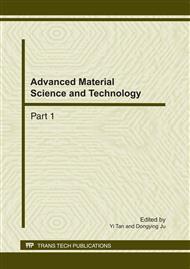p.391
p.395
p.399
p.403
p.407
p.411
p.415
p.419
p.423
Effects of Arc Discharge on Wear Properties of Carbon-Carbon Composites Sliding against Cu Trolley under Electric Current
Abstract:
Influence of arc discharge to the contact strip of carbon-carbon composites was orthogonally studied on the HST-100 tribo-tester under electric current, which simulated working conditions of the pantograph-wire system used in electric railway. The regression equation between specific wear rate and arc discharge were obtained and analyzed through the non-linear regression and orthogonal design. The results of the experiments show that a power function between specific wear rate and arc discharge was obtained. Microstructure and phase composition were observed and analyzed by scanning electron microscope(SEM), energy dispersive X-ray spectrum(EDS) and temperature sensor. The results revealed that the arc discharge dissipation seriously affects tribological characteristics of the carboncarbon composites. The temperature of some local contact points beyond their melting point with the electric arc heat effect, and give rise to the desposite carbon and friber carbon were vaporazated, which form the lubrication film on the wear surface, and with the augmant of the arc discharge, the area of lubrication film of carbon was decrease. Therefore, the main wear form of the arc erosion of the carbon-carbon composites is evaporate erosion and material transfer.
Info:
Periodical:
Pages:
407-410
Citation:
Online since:
February 2011
Authors:
Keywords:
Price:
Сopyright:
© 2011 Trans Tech Publications Ltd. All Rights Reserved
Share:
Citation:


